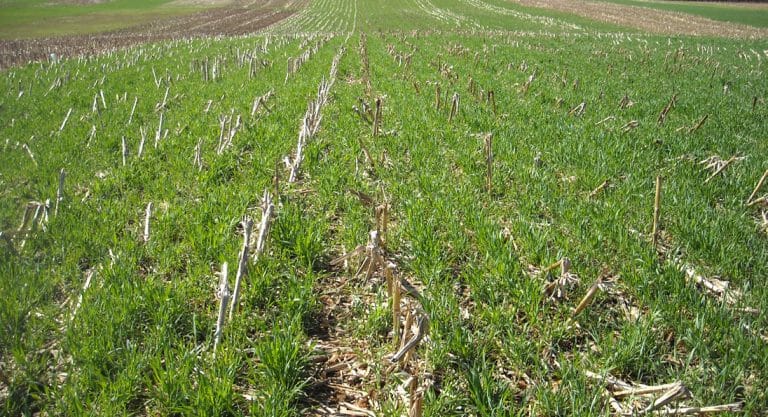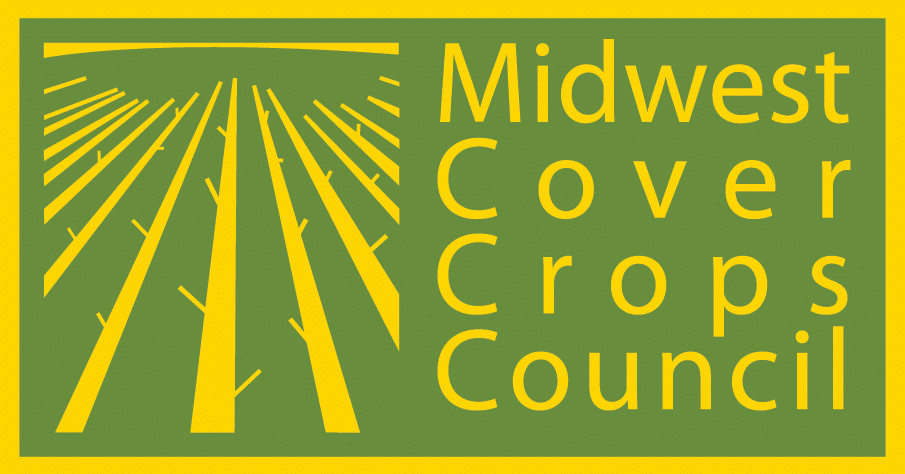Jennifer Woodyard and Nathan Johanning – University of Illinois Extension; Shalamar Armstrong – Purdue University
February 2019
This publication is intended to provide a starting point for farmers who are new to growing cover crops. With experience, farmers may fine-tune the use of cover crops for their systems.
INTRODUCTION
The following recipe provides an introductory approach to integrating a cover crop into a corn-soybean rotation. Planting a cover crop ahead of a soybean cash crop is often the easiest way to introduce cover crops into your rotation.
PLANNING AND PREPARATION
– Planning—Educate yourself. Start small. Be timely. Prioritize management based on your purpose and objectives.
– Corn hybrid and planting—If possible, plant the preceding corn crop early and use an early maturity corn hybrid. One strategy is to use cover crops on the field you usually harvest first, on sloping ground, or on a field where you can watch it regularly, and to plant your earliest maturity hybrid on that field.
– Residual corn herbicides—Cereal rye can be seeded and a successful stand will occur in the fall following most of the spring-applied residuals used in corn. However, if cereal rye will be grazed or fed to livestock, there are some restrictions (see Resources section).
– Seed purchase—Order cereal rye seed early. Named varieties can produce substantially more growth or more predictable growth and maturity, but they are more expensive than VNS (variety not stated) seed. Start with VNS seed with a good germination rate purchased from a reputable seed dealer. Note that this means the seed has been cleaned, tested for germination, and has a seed tag even though it is VNS.
FALL WORK
– Corn harvest—Harvest fields where cereal rye is to be planted as early as possible.
– Tillage or no-tillage—To allow for adequate cover crop growth, it is best or easier if no full-width tillage is planned for after rye planting or before intended rye termination date. Thus, it is easier to integrate cover crops into no-till or strip-till systems.
– Timing of planting—Ideally, plant cereal rye as soon after harvest as possible and before two weeks after the 50% frost date. In northern Indiana, this would be before Nov. 10; in southern Indiana, before Nov. 25. Use the Selector Tool for more precise dates for your county.
– Seeding rate—Drilled seeding rate: 45–60 lbs./acre. Broadcast with shallow incorporation: 50–65 lbs./acre. These rates are based on high-quality seed with germination rates of 85–98%.
– Planting method—Drill to 0.75–1.50 inches deep or broadcast with shallow incorporation. An air-seeder mounted on a vertical tillage tool can also be used.
– Fertility or liming—If applying P, K, or lime, complete the application prior to the seeding operation or apply to the growing rye before the ground freezes. If it is necessary to inject manure, low-disturbance injectors are available that will cause minimal damage to the cereal rye. Surface application of liquid manure on top of the rye is not recommended. Surface broadcast of dry manure or litter should be done prior to seeding, but 4 tons or less can be applied to growing cereal rye with minimal damage by using modern spreading equipment that provides even distribution.

Figure 1: Terminate cereal rye growth when approximately 6 inches in height (shown here). (Eileen Kladivko)
SPRING WORK
– Scouting—In the spring, scout your cereal rye cover crop to determine how well it is growing and its coverage. But if rainfall is below normal, scout also to monitor soil moisture in case earlier termination is needed.
– Termination timing—Terminate the cereal rye in the spring when plants are 6 to 12 inches tall and actively growing or about two weeks before planting soybean— whichever comes first. Many growers will successfully plant soybean into terminated cereal rye much taller than 12 inches, especially if weed control is a primary purpose, but new cover crop users should terminate when the cereal rye is smaller (see Figure 1).
– Termination herbicide—Cereal rye can easily be terminated with a full rate of glyphosate (minimum of 1 lb. acid equivalent [ae]/acre) after dormancy breaks in the spring. Effectiveness and rapidity of termination improves if rye is rapidly growing and air temperatures are warmer. Larger rye, rye past the boot stage, or rye sprayed during cooler weather can be more difficult to kill or will die more slowly. Be careful of metribuzen and metribuzen premixes antagonizing glyphosate if weather is cool and cloudy near the application date.
– Termination modifications for dry weather—Watch the weather and be ready to modify your termination plans. In a dry spring, the cereal rye cover crop has the potential to use moisture that the cash crop will need, so terminate cover crops sooner to allow rainfall to make up the deficit.
– Termination modifications for wet weather—In a wet spring, when it has been very difficult to get into the fields to spray, be ready to take advantage of any break in the weather and/or use low axle weight sprayers. If projected soybean planting is less than 10 days away and the rye is tall, then it often works better to spray within a day or two of planting. It is usually better to plant either into brown, dead rye plants or into standing green plants rather than into large, dying, yellow/green (“rubbery”) cereal rye plants that have fallen on the soil surface and formed a mat. See Purdue Extension publication AY-353-W (in Resources section) for more details.
– Soybean planting—It is usually best to no-till plant soybean into the dead/dry or standing cereal rye cover crop. Almost all modern planters and drills are fully capable of planting soybean into a cereal rye cover crop. Check planting depth and seed furrow closure shortly after beginning to plant into the cover crop residue as usually some adjustments are needed.
– Scouting—After soybean planting, scout for soybean emergence and population. Additionally, scout for weeds since substantial cereal rye residue can often delay emergence of annual weeds, which may delay the application of post-emergence herbicides.
RESOURCES
Cover Crop Selector Tool — available from the Midwest Cover Crops Council
Managing Cover Crops: An Introduction to Integrating Cover Crops into a Corn-Soybean Rotation (Purdue Extension publication AY-353-W)
Residual Herbicides and Fall Cover Crop Establishment (Purdue Extension Weed Science publication)
Terminating Cover Crops: Successful Cover Crop Termination with Herbicides (Purdue Extension publication WS-50-W)
Recommended Cover Crop Seeding Methods and Tools (Agronomy Technical Notes)—available from the USDA–Natural Resources Conservation Service
AUTHORS
Eileen Kladivko, Purdue University; Shalamar Armstrong, Purdue University; and Anna Morrow, Midwest Cover Crops Council
REVIEWERS AND CONTRIBUTORS
Marisol Berti, North Dakota State University; Barry Fisher, USDA-NRCS; William Johnson, Purdue University; Tom Kaspar, USDA–Agricultural Research Service (retired); DeAnn Presley, Kansas State University; Vaughn Sothman, Sharp Brothers Seed Co., Kansas; and Anne Verhallen, Ontario Ministry of Agriculture, Food and Rural Affairs
THE MIDWEST COVER CROPS COUNCIL (WWW.HTTPS://WWW.MIDWESTCOVERCROPS.ORG) AIMS TO FACILITATE WIDESPREAD ADOPTION OF COVER CROPS THROUGHOUT THE MIDWEST BY PROVIDING EDUCATIONAL/OUTREACH RESOURCES AND PROGRAMS, CONDUCTING NEW RESEARCH, AND COMMUNICATING ABOUT COVER CROPS TO THE PUBLIC.
FUNDING FOR THIS PROJECT WAS PROVIDED BY MCKNIGHT FOUNDATION.
Revised May 2019
The U.S. Department of Agriculture (USDA) prohibits discrimination in all its programs and activities on the basis of race, color, national origin, age, disability, and where applicable, sex, marital status, familial status, parental status, religion, sexual orientation, genetic information, political beliefs, reprisal, or because all or a part of an individual’s income is derived from any public assistance program. (Not all prohibited bases apply to all programs.) Persons with disabilities who require alternative means for communication of program information (Braille, large print, audiotape, etc.) should contact USDA’s TARGET Center at (202) 720-2600 (voice and TDD). To file a complaint of discrimination write to USDA, Director, Office of Civil Rights, 1400 Independence Avenue, S.W., Washington, D.C. 20250-9410 or call (800) 795-3272 (voice) or (202) 720-6382 (TDD). USDA is an equal opportunity provider and employer. ©2019 by MCCC. All rights reserved.
